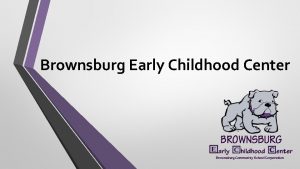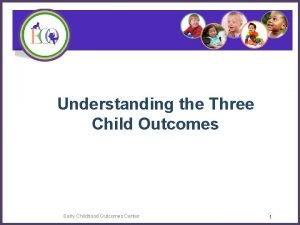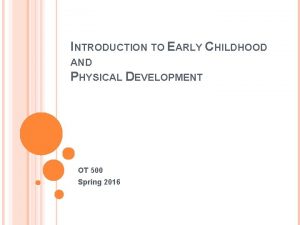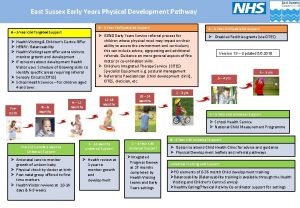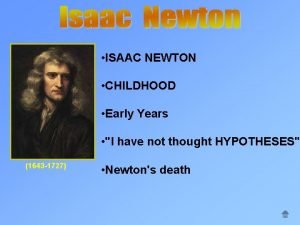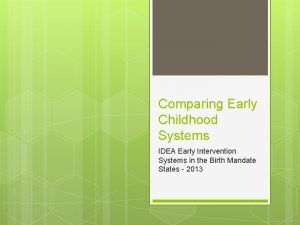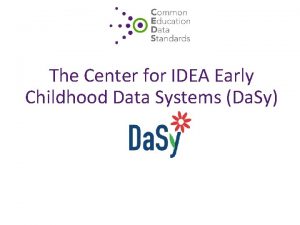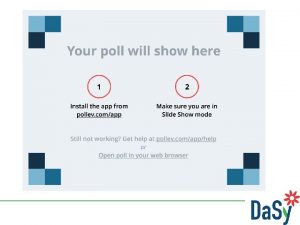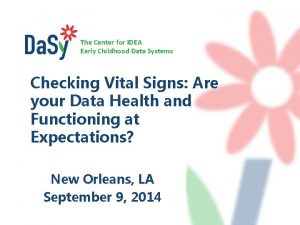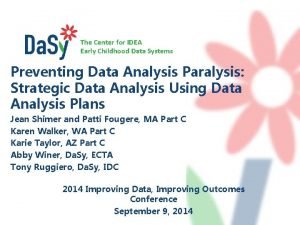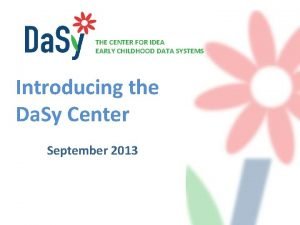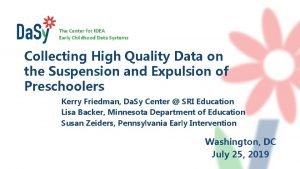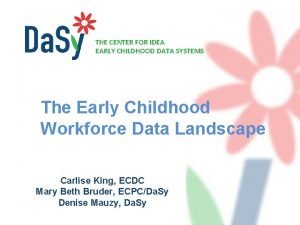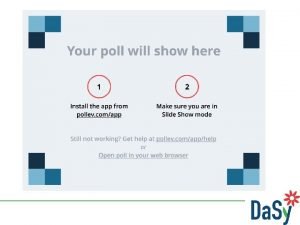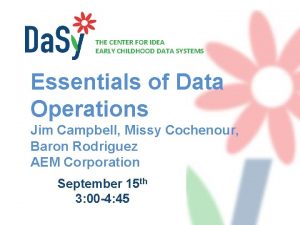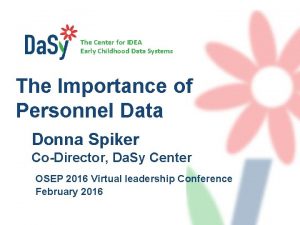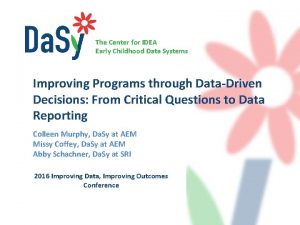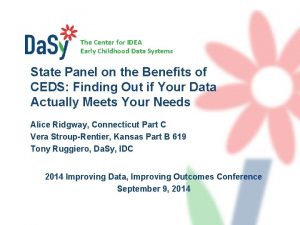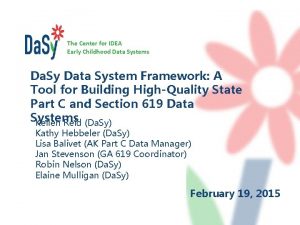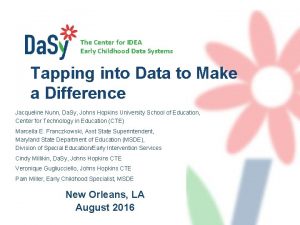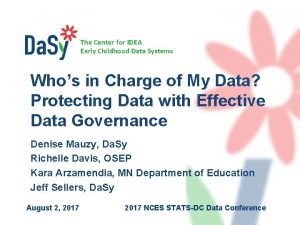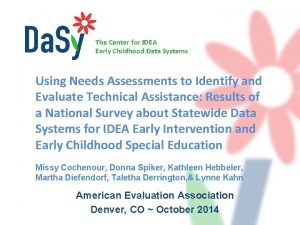The Center for IDEA Early Childhood Data Systems





























- Slides: 29

The Center for IDEA Early Childhood Data Systems Start Using Process and Data Models Robin Nelson Bruce Bull 2016 Improving Data, Improving Outcomes Conference New Orleans, LA August 2016

Who are we? Robin Nelson, Da. Sy Bruce Bull, Da. Sy, CIID (Together we have 45+ years in state government, 40+ in Part C and Part B) 2

Who are you? Roles? System design/development experience? Process and data model experience? 3

Objectives and Expectations Our Expectations: Process and data models are excellent tools for communication between technical and content staff. Developing and using these models provides all parties a clear understanding of what the data system is (or will be) designed to do. This session will introduce the models and how Part C and B staff might work with IT/technical staff in developing business requirements. Your Expectations: ? ? ? 4

Agenda Overview Business Requirements Introduce Process Models – Exercise: You develop a process model Introduce Data Models – Exercise: You develop a high level data model Benefits of Models and Suggestions for Use 5

Business Requirements Da. Sy Glossary: Constraints, demands, necessities, needs, or parameters of the data system defined by the consumer, that must be met or satisfied, usually within a certain timeframe. – The critical activities of an enterprise that must be performed to meet the organizational objective(s) while remaining solution independent. Types of requirements – Functional Requirements – Impact the Business Process – Technical Requirements – System Infrastructure – Operational Requirements – Operations & Support – Transitional Requirements – Implementation 6

Business Requirements: Levels of Detail 7

Business Requirements Business requirements: Are high level requirements (that management would understand) So that. . . Functional requirements: Can be detailed to: inform what is to be delivered and read by business analysts, developers, project manager and testers. 8

Purpose of Business Requirements Establish agreement with stakeholders Provide foundation to communicate with IT the solution (what, not how) to satisfy customer’s and business’ needs Provide input for next phase of project 9

Da. Sy BR Resources 10

Process Models: Overview Visual representation of business operations, including activities performed and how information moves among activities. Inventory of processes including relationships and sequencing Start with major processes, break down into sub-processes, as needed 11

Process Model for Car Rental 12

Process Model 1 Exercise Traveling to NOLA: – Start: Leave home (travel via air) – End: Arrive at hotel front door Materials (small Post-Its, markers, large paper/wall) Model should support events of all users Suggestion: Connect events and steps with arrow at the end 13

Process Model 2 Exercise Draft a process model for the development of an INITIAL IFSP/IEP – What are the high level processes needed? (E. g. , What processes support securing child’s present level of development/performance? What processes support establishing annual goals, outcomes? In what areas? Planned services/instruction/related services? – Select one process and break it down into necessary process subfunctions/subcomponents Form teams: Part C or Part B/619 14

Process Models: Sharing and Discussion Are the models alike? How granular are they? Insights? Challenges? 15

Process Models: IT Discussion It is relatively easy to communicate about understandable events. . . When discussing content processes (IFSP/IEP, referral, transition, etc. ) with IT: – How would the discussion change? – Who would “draw” the process model? 16

Data Models: Overview Visual representation of the organization and structure of the data Abstract model that documents and organizes the business data Depicts all data requirements of the system Identifies all entities Identifies characteristics (attributes) of those entities Describes the relationships between the entities 17

Data Models: Video Overview Gotta love You. Tube! https: //www. youtube. com/watch? v= O 4 PXqpv 8 TAw 18

Simple ERD 1 for Child and Family Characteristics and Child Outcomes ERD: Entity Relationship Diagram 19

Data Models: Exercise In your original group, think about the data needed to support the IFSP/IEP process Draw a data model (ERD) that depicts the types of data, characteristics of that data, and the relationships among the data 20

Data Models: Sharing and Discussion Insights Challenges When discussing with IT: – How would the discussion change? – Who would “draw” the data model? 21

Using Models in Developing Business Requirements 22 Paul R. Smith & Richard Sarfaty Publications, 2009

Connections to Da. Sy Framework SD 2: Part C/619 state staff are actively involved in the development of business requirements, process models, and data models for the data system/enhancement. – SD 2 b, SD 2 c, SD 2 e SD 3: The requirements analysis defines the full set of requirements for the new data system or enhancement—that is, what it must do. – SD 3 e, SD 3 f, SD 3 g, SD 3 h, SD 3 i 23

Building a Better Data System: What Are Process and Data Models? 24

Main Benefit of Modeling Improved Communication!!! Analyze and communicate the needs of the program in a non-technical manner. – Shared representation of the program – Helps IT staff learn about the program, helps program staff communicate needs – In the language of the program Data model depicts all data requirements 25

Additional Benefits of Modeling Higher quality applications Reduced cost Faster development Faster application with fewer errors Better documentation 26

Questions / Contact “Hmms, buts, whats, and duhs” Robin Nelson – ropnelson@hotmail. com Bruce Bull – Bruce. Bull@SPEDSIS. com 27

How to Stay in Touch with Da. Sy Visit the Da. Sy website at: http: //dasycenter. org/ Like us on Facebook: https: //www. facebook. com/dasycenter Follow us on Twitter: @Da. Sy. Center 28

The contents of this presentation were developed under a grant from the U. S. Department of Education, # H 373 Z 120002. However, those contents do not necessarily represent the policy of the U. S. Department of Education, and you should not assume endorsement by the Federal Government. Project Officers, Meredith Miceli and Richelle Davis. 29
 Principles of growth and development
Principles of growth and development Bellfort early childhood center
Bellfort early childhood center Becc brownsburg
Becc brownsburg Early childhood center flushing mi
Early childhood center flushing mi Early childhood outcomes center
Early childhood outcomes center The crane center ohio
The crane center ohio Types of early childhood programs
Types of early childhood programs Types of early childhood programs chapter 2
Types of early childhood programs chapter 2 Early childhood framework for quality
Early childhood framework for quality Efq
Efq Professional development program, rockefeller college
Professional development program, rockefeller college How to welcome parents in orientation
How to welcome parents in orientation Early childhood education and care directorate
Early childhood education and care directorate Leonardo da vinci childhood
Leonardo da vinci childhood Fine motor skills development in early childhood
Fine motor skills development in early childhood Trends in early childhood education
Trends in early childhood education Physical development in early childhood
Physical development in early childhood Ecrq
Ecrq Garda vetting form early childhood ireland
Garda vetting form early childhood ireland Psychosocial development in early childhood
Psychosocial development in early childhood Chapter 7 early childhood ages 3 through 5
Chapter 7 early childhood ages 3 through 5 Kellogg's developmental stages of art
Kellogg's developmental stages of art Amelia earhart early childhood
Amelia earhart early childhood Language development in early childhood
Language development in early childhood Prosposed
Prosposed Pedagogical leadership in early childhood
Pedagogical leadership in early childhood Isaac newton early childhood
Isaac newton early childhood Eminem early childhood
Eminem early childhood Ece in pakistan
Ece in pakistan A vygotskian classroom promotes ________.
A vygotskian classroom promotes ________.


